Indien |
|
|
|
| Übersicht – Contents: | |
|
|
Diese Seite ist Teil des Projektes
Indien |
|
|
|
| Übersicht – Contents: | |
|
|
Flaggen – Flags: |
|
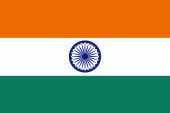 |
Nationalflagge und Gösch – national flag and jack, Seitenverhältnis – ratio = 2:3, Quelle/Source, nach/by: Corel Draw 4   |
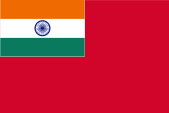 |
Handelsflagge – merchant flag, Seitenverhältnis – ratio = 2:3, Quelle/Source, nach/by: Flaggen und Wappen |
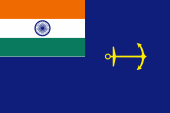 |
Staatsflagge zur See (Seedienstflagge), – State ensign (official flag at sea) Seitenverhältnis – ratio = 2:3, Quelle/Source, nach/by: Flags of the World |
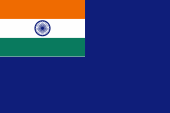 |
Handelsflagge für Reserveoffiziere der Marine und Flagge der Hilfsschiffe –
Merchant flag for Naval Reserve Officers and flag of auxiliary ships, Seitenverhältnis – ratio = 2:3, Quelle/Source, nach/by: Flags of the World |
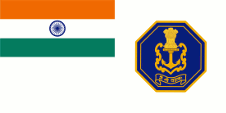 |
seit/since 2022, Marineflagge – naval flag, Seitenverhältnis – ratio = 1:2, Quelle/Source, nach/by: Flags of the World, Indian Navy, Public domain, via Wikimedia Commons |
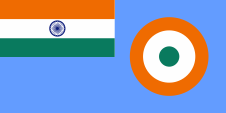 |
Flagge der Luftwaffe – flag of the Air Force, Seitenverhältnis – ratio = 1:2, Quelle/Source, nach/by: Flags of the World |
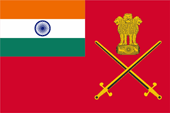 |
Flagge des Heeres – flag of the army, Seitenverhältnis – ratio = 2:3, Quelle/Source, nach/by: Flags of the World |
Bedeutung/Ursprung der Flagge – Meaning/Origin of the Flag: |
|
| Die heutige Flagge Indiens wurde am 22.07.1947, im Vorfeld der Unabhängigkeit am 15.08.1947 eingeführt. Sie zeigt drei waagerechte Streifen in Safran, Weiß und Grün. In dem weißen Mittelstreifen wurde ein blaues Rad platziert. Es handelt sich um das religiöse Symbol "Rad der Lehre". Es geht auf Kaiser Ashoka zurück, der Indien zwischen 270–232 v. Chr. einte und regierte. Zum buddhistischen Symbol wurde es, weil Buddhas erste Predigt bei Benares als das "Ingangsetzen des Rades der Lehre" (Tschakra) bezeichnet wurde. Die Farbe Safran steht offiziell für Mut und Aufopferung, Weiß für Frieden und Vertrauen, Grün für Treue und Ritterlichkeit. Inoffiziell steht das Safran für die Hindus, das Grün für die Moslems und das Weiß für den versöhnlichen Geist zwischen ihnen. Die Flagge Indiens hat ihre Wurzeln in der Flagge des Indischen Nationalkongresses von 1931, und geht auf Subhas Chandra Bose (1897–1945) zurück (siehe hier). Zur Unabhängigkeit wurde das im weißen Mittelstreifen gelegene blaue Spinnrad (Tscharkha), durch das Tschakra ersetzt. | The today's flag of India was introduced on 22nd of July in 1947 in advance of the independence on the 15th of August in 1947. It shows three horizontal stripes in saffron, white and green. Into the white middle stripe was placed a blue wheel. This is the religious symbol "wheel of tutorage". It goes back to the emperor Ashoka which united and ruled India between 270 and 232 B.C. It became to a buddhistic symbol, because Buddha's first near Benares pronounced sermon was named "turning on the wheel of tutorage" (Chakra). The colour saffron stands officially for courage and sacrifice, white for peace and trust, green for loyalty and chivalry. Unofficial stands the saffron for the hindus the green for the muslims and the white for the forgiving spirit between them. The flag of India has it's roots in the flag of the Indian National Congress from 1931, and goes back to Subhas Chandra Bose (1897–1945, look here). In context with the independence was displaced the in the blue middle stripe positioned blue spin wheel (Charkha) by the Chakra. |
| Die Fürstenstaaten – die alle eigene Flagge hatten – wurden 1950 endgültig abgeschafft. An ihre Stelle traten künstlich geschaffene Bundesstaaten, die bis auf eine einzige Ausnahme (ehemals Jammu und Kaschmir) keine Flaggen verwenden. | The prince's states – which all had their own flags – were ultimately abolished in 1950. They got substituted by factitiously created federal states which use no own flags except one exception (former Jammu and Kashmir). |
| Indien orientiert sich am britschen Ensign-System. Das weißt auf die früheren Verbindungen zu Großbritannien hin (→ Britisch-Indien). Die Farben der Flagge sind wie folgt definiert: Safrangelb = Pantone 021, Grün = Pantone 341, Marineblau = Pantone 662. | India is orientated in the British Ensign-System. This points to the former connexions to United Kingdom (→ British India). The colors of the flag are defined as follows: Saffron Yellow = Pantone 021, Green = Pantone 341, Navy Blue = Pantone 662. |
| Quelle/Source: Die Welt der Flaggen, Flaggen Wappen Hymnen, Flaggen und Wappen der Welt, Wikipedia (DE) | |
historische Flaggen – historical Flags: |
Indien – India: |
|
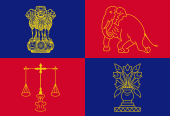 |
1950–1971, Flagge des Präsidenten – flag of the president, Seitenverhältnis – ratio = 2:3, Quelle/Source, nach/by: Flaggen und Wappen |
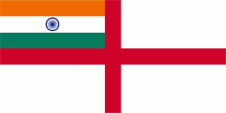 |
1950–2001, Marineflagge – naval flag, Seitenverhältnis – ratio = 1:2, Quelle/Source, nach/by: Flags of the World |
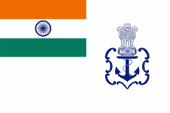 |
2001–2004, Marineflagge – naval flag, Seitenverhältnis – ratio = 2:3, Quelle/Source, nach/by: Flags of the World |
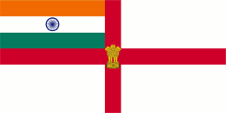 |
2004–2014, Marineflagge – naval flag, Seitenverhältnis – ratio = 1:2, Quelle/Source, nach/by: Flags of the World |
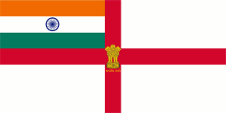 |
2014–2022, Marineflagge – naval flag, Seitenverhältnis – ratio = 1:2, Quelle/Source, nach/by: Flags of the World |
|
|
|
Britische Ostindienkompanie – British East India Company: |
|
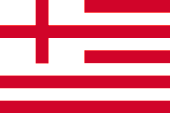 |
ca. 1615–1707, Flagge der Englischen Ostindienkompanie – flag of English East India Company, Quelle/Source, nach/by: commons.wikimedia.org |
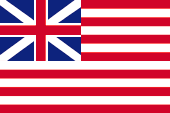 |
1707–1801, Flagge der Britischen Ostindienkompanie – flag of British East India Company, Quelle/Source, nach/by: commons.wikimedia.org |
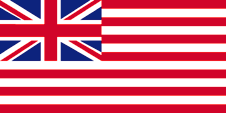 |
1801–1858, |
|
|
|
| Die Flaggen der Ostindienkompanie zeigten seit Anfang des 17. Jahrhunderts weiße und rote Streifen, um deren Schiffe besser von anderen britischen Schiffen zu unterscheiden. | The flags of the East India Company showed since the beginning of the 17th century white and red stripes, to differentiate better its ships from the other British ships. |
| mehr Informationen? → hier klicken | more informations → click here |
Britisch-Indien – British India: |
|
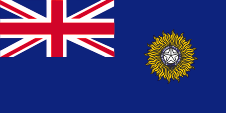 |
1879–1947, Flagge der Regierung (Staatsflagge) – flag of the government (state flag), Seitenverhältnis – ratio = 1:2, Quelle/Source, nach/by: Flags of the World |
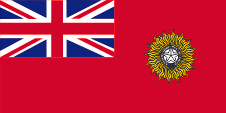 |
1945–1947, inoffiziell – unofficial Handelsflagge – merchant flag, Seitenverhältnis – ratio = 1:2, Quelle/Source, nach/by: Flags of the World |
 |
1879–1928, Marineflagge – naval flag, Seitenverhältnis – ratio = 1:2, Quelle/Source, nach/by: Flags of the World |
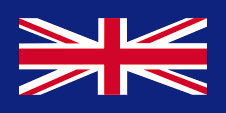 |
1879–1928, Gösch – naval jack, Seitenverhältnis – ratio = 1:2, Quelle/Source, nach/by: Flags of the World |
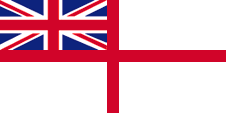 |
1928–1947, Marineflagge – naval flag, Seitenverhältnis – ratio = 1:2, Quelle/Source, nach/by: Flags of the World |
 |
1928–1947, Gösch – naval jack, Seitenverhältnis – ratio = 1:2, Quelle/Source, nach/by: Flags of the World |
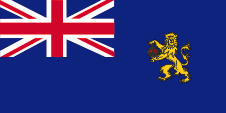 |
1884–1947, Local Maritime Government Ensign, Seedienstflagge – official flag at sea, Seitenverhältnis – ratio = 1:2, Quelle/Source, nach/by: Flags of the World |
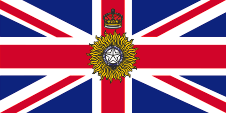 |
1885–1947, Flagge des Vizekönigs und Generalgouverneurs von Britisch-Indien – flag of the Vice King and Governor General of British India, Seitenverhältnis – ratio = 1:2, Quelle/Source, nach/by: Flags of the World |
|
|
|
Großbritannien hatte in Jahr 1864 ein Flaggensystem eingeführt, in dem:
Seit 1865 durften Schiffe von Kolonialregierungen einen Blue Ensign mit einem Badge (Abzeichen) im fliegenden Ende führen. Die jeweiligen Regierungen sollten entsprechene Bagdes zur Verfügung stellen. Handelsschiffe und seefahrende Privatpersonen aus Kolonien dürfen nur dann einen Red Ensign mit Badge führen, wenn von der britischen Admiralität eine entsprechende Erlaubnis für die Kolonie erteilt wurde. |
United Kingdom introduced a flag system in 1864 in which:
Since 1865 ships of colonial governments were permitted to fly the Blue Ensign with a badge in the flying end of the flag. The respective governments were asked to design appropriate badges. Merchant ships and seafaring persons from colonies were only permitted to use the Red Ensign with a badge, then also named Civil Ensign, if permission has been given to the respective colony by the British admiralty. |
| Das Symbol Britisch-Indiens war der Stern von Indien, ein siberner fünfzackiger Stern umgeben von einem blauen Band mit dem Motto: "Das Licht des Himmels unser Führer", eingebettet in goldene Sonnenstrahlen. | The symbol of British India was the Star of India, a silvery five-pointed star surrounded by a blue ribbon with the motto: "The Light of Heaven our Guide ", embedded in golden sun rays. |
| Die Unterwerfung Indiens durch Großbritannien war bis zum Jahre 1856 weitgehend abgeschlossen worden, 1858 übernahmen die Briten offiziell den Thron des Mogulreiches, und im Jahr 1877 nahm die britische Königin Viktoria den Titel „Kaiserin von Indien“ an. Indien war nunmehr ein Flickenteppich aus Gebieten die durch die Britische Ostindische Kompanie, bzw. direkt durch Großbritannien verwaltet wurden, und Territorien einheimischer Fürsten die lediglich die britische Oberhoheit anerkannten (Vasallen). All diese Gebiete setzten ihre eigene einheimische Heraldik fort, teilweise ergänzt um britische Symbolik, z.B. durch Einführung eines Red Ensign, oder Einführung eines Blue Ensign. Die Fürstenstaaten wurden 1950 endgültig abgeschafft. An ihre Stelle traten künstlich geschaffene Bundesstaaten, die bis auf eine einzige Ausnahme (Jammu und Kaschmir) keine Flaggen verwenden. | The
conquest of India by United Kingdom was appreciably finished until the year
1856, in 1858 the British took officially over the throne of the
Mogul-Empire, and in the year 1877 the British queen Victoria adoped the
title „Empress of India“. India was now a patchwork carpet from territories administered by the British East Indian Company, respectively directly by United Kingdom, and territories of indigenous princes which merely recognized the British supremacy (vassals). All this territories maintained their own native heraldry partially completed by British symbolism, for instance by introduction of a Red Ensign, or introduction of a Blue Ensign. The prince's states were ultimately abolished in 1950. They got substituted by factitiously created federal states which use no own flags except one exception (Jammu and Kashmir). |
| Quelle/Source: Die Welt der Flaggen, Flaggen und Wappen der Welt, Wikipedia (DE) | |
Portugiesisch-Indien – Portuguese India: |
|
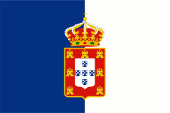 |
1830–1910, |
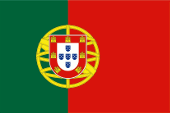 |
1911–1961, |
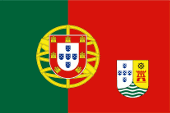 |
60-er Jahre 19. Jhd. / sixties of the 19th cent., geplante Flagge für Portugiesisch-Indien – purposed flag for Portuguese India, Seitenverhältnis – ratio = 2:3, Quelle/Source, nach/by: Wikipedia (D) |
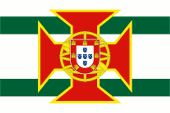 |
1935–1961, Flagge des Generalgouverneurs – flag of the Governor General, Seitenverhältnis – ratio = 2:3, Quelle/Source, nach/by: Die Welt im bunten Flaggenbild  |
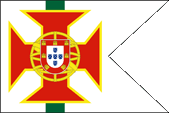 |
1935–1961, Flagge eines Distriktskommandanten in Portugiesisch-Indien – flag of a District Commandant in Portuguese India, Seitenverhältnis – ratio = 2:3, Quelle/Source: nach by: Flaggenbuch 1939  |
|
|
|
| Zwischen dem 16. und 18. Jahrhundert unterhielt Portugal zahlreiche städtische Besitzungen und Stützpunkte an der Ost- und Westküste Indiens und in Ceylon. Im 19. Jahrhundert waren davon noch fünf an der Westküste übrig geblieben: das 1535 erworbene Diu, das 1559 erworbene Daman, das 1779 erworbene Dadra, das 1779 erworbene Nagar-Haveli und die größte Besitzung, das 1509 erworbene Goa. Dadra und Nagar-Haveli gingen 1954 durch eine Okkupation durch indische Nationalisten verloren. Sie sind heute ein Unionsterritorium Indiens. Goa, Diu und Daman wurden 1961 von der indischen Armee besetzt und entgegen des Befehls des portugiesischen Präsidenten aufgegeben. Diu und Daman sind heute ein Unionsterritorium Indiens und Goa mit 3700 km² der kleinste indische Bundesstaat. | Between the 16th and 18th centuries, Portugal operated numerous urban possessions and bases on the eastern and
western coast of India and in Ceylon. In the 19th century there were still five of them left on the western coast: the in 1535 acquired Diu, the in 1559 acquired Daman, the in 1779 acquired Dadra, the in 1779 acquired Nagar-Haveli and the largest estate, the in 1509 acquired Goa. Dadra and Nagar-Haveli were lost in 1954 by an occupation by Indian nationalists. They are now a union territory of India. Goa, Diu and Daman were in 1961 occupied by the Indian army and became abandoned against the command of the Portuguese President. Diu and Daman are today a union territory of India and Goa, with its 1429 sq.mi., is the smallest Indian federal state. |
| In den portugiesischen Kolonien wurde ausschließlich die portugiesische Nationalflagge verwendet, da man die Kolonien als fester Bestandteil des Mutterlandes betrachtete, und nicht als Außenbesitzungen. Das bedeutete, das portugiesische Kolonien nie eigene Flaggen hatten, auch wenn es in den sechziger Jahren des 20. Jahrhunderts Bestrebungen gab Flaggen für die Kolonien einzuführen, indem man das Wappen der Kolonie in das fliegende Ende der portugiesischen Nationalflagge platzierte. Diese Pläne wurden jedoch nie realisiert. | In the
Portugese colonies was solely in use the Portugese national flag
because they saw the colonies as permanent component of the motherland and
not as outer possessions. This implys that Portugese
colonies never had own flags, even if there were ambitions in the sixties of
the 20th century to introduce flags for the colonies by placing of the coat
of arms of the colony in the flying end of the Portugese national flag. But
this plans became never realized. |
| Quelle/Source: 1) Wikipedia (D), 2) Wikipedia (D) | |
Französisch-Indien – French India: |
|
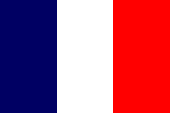 |
1794–1954, |
|
|
|
| In der Mitte des 18. Jahrhunderts war der französische Einfluss, ausgehend von umfangreichen Besitzungen an der Ostküste, beträchtlich angewachsen. Nach dem für Frankreich verlorenen Siebenjährigen Krieg (1756 bis 1763) gingen diese Besitzungen nahezu vollständig an Großbritannien über. Lediglich fünf Städte blieben als Französische Besitzungen erhalten: das 1751 erworbene Yanam (Yanaon), das 1738 erworbene Karikal (Karaikal), das 1674 erworbene Pondichéry (Puducherry), das 1721 erworbene Mahé und das 1673 durch Franzosen gegründete Chandannagar (Chandernagor). Chandannagar wurde 1950 nach einer Volksabstimmung an Indien übergeben. Die verbleibenden vier Besitzungen kamen 1954 an Indien und sind heute ein Unionsterritorium Indiens. |
In the middle of the 18th century, the French influence, based on extensive possessions on the
eastern coast, had grown considerably. After the "Seven Years War" (1756 to 1763) – lost by France – these possessions were almost entirely transferred to the United Kingdom. Only five cities remained as French possessions: the in 1751 acquired Yanam (Yanaon), the in 1738 acquired Karikal (Karaikal), the in 1674 acquired Pondichéry (Puducherry), the in 1721 acquired Mahé and the in 1673 by Frenchman founded Chandannagar (Chandernagor). Chandannagar was handed over to India in 1950 after a referendum. The remaining four possessions came to India in 1954 and they are now a union territory of India. |
| In den französischen Kolonien wurde ausschließlich die französische Nationalflagge verwendet, da man die Kolonien als fester Bestandteil des Mutterlandes betrachtete, und nicht als Außenbesitzungen. Das bedeutete, das diese Kolonien nie eigene Flaggen hatten. | In the
French colonies was solely in use the French national flag
because they saw the colonies as permanent component of the motherland and
not as outer possessions. That implys that these colonies never had own flags. |
| Quelle/Source: FOTW, Die Welt der Flaggen, Wikipedia (D) | |
Wappen – Coat of Arms: |
|
 |
Wappen von Indien – coat of arms of India Quelle/Source: Corel Draw 4 |
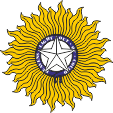 |
1879–1947, Abzeichen Britisch-Indien – badge of British India Quelle/Source, nach/by: Flags of the World |
 |
1935–1961, Wappen Portugiesisch-Indien – coat of arms of Portuguese India Quelle/Source, nach/by: Wikipedia (D) |
Bedeutung/Ursprung des Wappens – Meaning/Origin of the Coat of Arms: |
|
| Das Staatswappen Indiens wurde am 26.01.1950, im Zusammenhang mit der Annahme einer neuen Verfassung angenommen. Die indischen Flaggen zeigen das Wappen jedoch nicht, lediglich die Flagge des Präsidenten verwendet es in der linken Oberecke. Es ist einer Säule in der heiligen Stadt Sarnath nachgebildet, und zeigt einem Sockel mit Kaiser Ashokas Rad in der Mitte, darauf vier Löwen, die in die vier Himmelsrichtungen blicken. Darunter ein Zitat in Sanskrit aus den Mundaka-Upanischaden: "Nur die Wahrheit siegt". | The coat
of arms of India was adoped on 26th of January in 1950 in occasion with the
passing of a new constitution. The Indian flags do not show the coat of
arms, merely and is not to see on the indian flags, merely the flag of the
president uses it in the left upper canton. It is reproduced by a column in the holy town Sarnath and shows a plinth with emperor Ashokas wheel in the middle, thereupon four lions which look in the four directions. Underneath a quotation in Sanskrit out of the Mundaka Upanishades: "only the truth wins". |
| Das Symbol Britisch-Indiens war der Stern von Indien, ein siberner fünfzackiger Stern umgeben von einem blauen Band mit dem Motto: "Das Licht des Himmels unser Führer", eingebettet in goldene Sonnenstrahlen. | The symbol of British India was the Star of India, a silvery five-pointed star surrounded by a blue ribbon with the motto: "The Light of Heaven our Guide ", embedded in golden sun rays. |
| Im Jahre 1935 wurden für die portugiesischen Kolonien eigene Wappen eingeführt. Die Gestaltung unterlag einem gewissen Schema und so zeigte jedes Wappen neben einer lokalen Symbolik die fünf Quinas aus dem Wappen von Portugal und fünf grüne Wellen auf Silber. Als lokale Symbolik erschien im Wappen von Portugiesisch-Indien ein rotes Kastell und ein Steuerrad. | In the year 1935 own coats of arms were created for the Portuguese colonies. The design was subject to a special scheme. So each coat of arms contained, in addition to a local symbolism, the five Quinas from the coat of arms of Portugal and five green waves on silver. As the local symbolism in the coat of arms of Portuguese India appeared a red castle and a steering wheel. |
| Quelle/Source: Die Welt der Flaggen, Flags of the World, Wikipedia (D) | |
Flugzeugkokarde – aircraft roundel: |
|
 |
1947–1950, Flugzeugkokarde – aircraft roundel Quelle/Source: nach/by Wikipedia (EN) |
 |
seit/from 1950, Flugzeugkokarde – aircraft roundel Quelle/Source: nach/by Wikipedia (EN) |
Landkarten – Maps: |
Lage – Position: |
Landkarte des Landes – Map of the Country: |
Zahlen und Fakten – Numbers and Facts: |
|
|
|
|
|
|
|
|
|
|
|
|
|
|
|
|
|
|
|
|
|
|
Geschichte: |
| ca. 2500
v.Chr. · neolithische vorarische Hochkulturen von Mohenjo-Daro und Harappa ca. 1500–500 v.Chr. · Einwanderung arischer Nomadenvölker nach Nord- und Nordwestindien (Wedisches Zeitalter) ca. 640 v.Chr. · beginnende Ausbreitung des Buddhismus 320–185 v.Chr. · Maurja-Großreich 270–232 v.Chr. · Regentschaft des Maurja-Königs Aschoka 320–467 n.Chr. · Gupta-Reich ab ca. 660 · Eindringen des Islam ab 1221 · wiederholte Mongoleneinfälle 1498 · der Portugiese Vasco da Gama erreicht Indien auf dem Seeweg 1503–1559 · Inbesitznahme verschiedener indischer Küstenstädte durch die Portugiesen, darunter auch für die nächsten 400 Jahre die Städte Goa, Diu und Daman 1526 · Gründung der mongolischen Kaiserdynastie (Moguln) des Babur in Dehli 1605–1663 · Inbesitznahme weiterer indischer Küstenstädte durch die Niederländer 1600 · Gründung und Privilegierung der Englischen Ostindienkompanie 1602 · Gründung der Niederländischen Ostindienkompanie 1611 · die Niederländer treten Mastsjulipattinam an die Englische Ostindienkompanie ab, Beginn der britischen Kolonisierung, zunächst auch nur durch Unterwerfung verschiedener Küstenstädte 1620 · Inbesitznahme von Trankebar durch Dänemark, 1845 an die Englische Ostindienkompanie abgetreten 1664 · Gründung der Französischen Ostindienkompanie 1674–1739 · Inbesitznahme weiterer indischer Küstenstädte durch die Franzosen 18. Jhd. · Aufstieg des Marathenreiches in Südindien, allmählicher Niedergang des Mogulreiches 1753 · Eroberung eines ersten größeren Landstriches (Küstenregion Sarkars) durch die Britische Ostindienkompanie 1765–1898 · die Briten (einschl. der Britischen Ostindienkompanie) unterwerfen nach und nach ganz Indien, was die heutigen Staaten Pakistan, Bangladesch und Burma einschließt 1778 · vier Inseln der Nikobaren-Inseln werden ungeachtet dänischer Ansprüche zu österreichischen Kronkolonien erklärt und die "Triestiner Ostindische Handelskompanie" gegründet 1784 · die Nikobaren werden von Österreich wieder aufgegeben, die "Triestiner Ostindische Handelskompanie" stellt ihre Arbeit ein 1813 · die Handelsprivilegien der Britischen Ostindienkompanie werden aufgehoben 1814 · die Niederlande treten ihre restlichen Besitzungen an die Briten ab 1833 · die Tätigkeit der Britischen Ostindienkompanie wird auf die Ausübung der Zivilverwaltung im Namen der Krone beschränkt 1846 · die Nikobaren-Inseln werden dänischer Besitz, 1869 an Großbritannien abgetreten 1858 · Großbritannien übernimmt offiziell den Thron des Mogulreichs, Indien wird britische Kolonie, die Britische Ostindienkompanie wird bedeutungslos (1873 aufgelöst) 1877 · die britische Königin Viktoria nimmt den Titel „Kaiserin von Indien“ an 1885 · Gründung des Indischen Nationalkongresses (Kongresspartei) 1906 · Gründung der Moslem-Liga 1919 · Bildung einer ersten eigenen Regierung für Britisch-Indien 1935 · Verfassungsreform, Gewährung teilweiser innerer Selbstverwaltung, die Provinzen erhalten Autonomie 1937 · Burma wird von Britisch-Indien abgetrennt und erhält innere Selbstverwaltung 1943–1945 · Subhas Chandra Bose versucht während des Zweiten Weltkrieges mit der Indischen National-Armee als Verbündeter Japans und Deutschlands die Unahängigkeit für ganz Indien zu erreichen 15.08.1947 · auf Grund religiöser Unruhen Teilung Britisch-Indiens in Indien (Hindus) und Pakistan (Moslems), Unabhängigkeit für beide Staaten als Dominions im Rahmen des britischen Commonwealth 1947–1949 · Erster Kaschmir-Krieg gegen Pakistan 26.01.1950 · Indien wird Republik, bleibt jedoch im Commonwealth 1954 · Frankreich gibt seine Besitzungen in Indien auf (Chandannagar - schon 1950, Pondichéry, Yanam, Mahé und Karikal) 1961 · Portugal gibt seine Besitzungen in Indien auf (Goa, Diu und Daman) 1962 · Grenzkrieg gegen China 1965 · Zweiter Kaschmir-Krieg gegen Pakistan 1971 · Krieg gegen Pakistan zur Unterstützung der Abspaltung Bangladeschs von Pakistan 1984 · Krieg gegen die Sikh-Separatisten, die für einen unabhängigen Sikh-Staat Khalistan kämpfen 1987 · Einmarsch indischer Truppen in Sri Lanka 1990 · Abzug der indischen Truppen aus Sri Lanka 1992–1993 · Auseinandersetzungen zwischen Hindus und Moslems 1999 · bewaffnete Aktionen zwischen Indien und Pakistan in Kaschmir 2019 · Abschaffung des Bundesstaats "Jammu und Kashmir", Aufteilung in die Unionsterritorien "Jammu und Kashmir" und "Ladakh" April/Mai 2025 · bewaffneter Konflikt zwischen Pakistan und Indien in der Kaschmir-Region |
History: |
| ca. 2500
B.C. · neolithic before-aryan high cultures of Mohenjo-Daro and Harappa ca. 1500–500 B.C. · immigration of Aryan nomad nations to North and Northwest India (Wedyan Age) ca. 640 B.C. · beginning expansion of the Buddhism 320–185 B.C. · Maurja Empire 270–232 B.C. · regency of the Maurja king Ashoka 320–467 A.D. · Gupta Empire since ca. 660 · penetration of the Islam since 1221 · repeated Mongolian invasions 1498 · the Portugese Vasco da Gama achieves India over the sea 1503–1559 · appropriation of diverse Indian coastal towns by the Portugese, among them – even for the next 400 years – the towns Goa, Diu and Daman 1526 · foundation of the Mongolian emperor's dynasty (Mughal) of the Babur in Dehli 1600 · establishment and privilegement of the English East India Company 1602 · establishment of the Dutch East India Company 1605–1663 · appropriation of further Indian coastal towns by the Dutch 1611 · the Dutch cede Mastsjulipattinam to the English East India Company, beginning of the British colonization, initially as well only by subjugation of diverse coastal towns 1620 · appropriation of Trankebar by Denmark, in 1845 ceded to the English East India Company 1664 · establishment of the French East India Company 1674–1739 · appropriation of further Indian coastal towns by the Frenchmen 18th cent. · ascent of the Marathe's Empire in South India, gradual decay of the Mogul Empire 1753 · capture of one first greater tract of land (Sarkars coastal region) by the British East India Company 1765–1898 · the British (incl. the British East India Company) submit step by step the whole India including the today's states Pakistan, Bangladesh and Burma 1778 · four islands of the Nicobar Islands are declared as Austrian crown colonies, despite of Danish claims, and the "Triestinian East India Trade Company" was founded 1784 · the Nicobar Islands become abandoned by Austria, the "Trieste East India Trade Company" ends their work 1813 · the privileges in trade of the British East India Company become terminated 1814 · the Netherlands cede their remaining possessions to the British 1833 · the activities of the British East India Company become limited to the exertion of the civil government in the name of the crown 1846 · the Nikobare Islands become a Danish possession, in 1869 ceded to United Kingdom 1858 · United Kingdom takes officially over the throne of the Mughal Empire, India becomes a British colony, the British East India Company becomes insignificant (dissolved in 1873) 1877 · the British queen Victoria adopes the title „Empress of India“ 1885 · foundation of the Indian National Congress (congress party) 1906 · foundation of the Moslem League 1919 · formation of a first own government for British India 1935 · constitutional reform, granting of partial internal self administration, the provinces get autonomy 1937 · Burma gets separated from British India and receives internal self administration 1943–1945 · Subhas Chandra Bose tries to achieve independence for whole India during the Second World War with the Indian National Army as an ally of Japan and Germany 15th of August 1947 · because of religious agitations partition of British India into India (Hindus) and Pakistan (Muslim), independence for both states as dominions within the British Commonwealth 1947–1949 · first Kashmir War against Pakistan 26th of January 1950 · India becomes republic, remains however in the Commonwealth 1954 · France cedes it's possessions in India (Chandannagar - already in 1950, Pondichéry, Yanam, Mahé and Karikal) 1961 · Portugal gives up it's possessions in India (Goa, Diu and Daman) 1962 · frontier war against China 1965 · second Kashmir War against Pakistan 1971 · war against Pakistan to support the separation of Bangladesh from Pakistan 1984 · war againsts the Sikh separatists which fight for an independent Sikh State of Khalistan 1987 · invasion of Indian troops in Sri Lanka 1990 · withdrawal of the Indian troops from Sri Lanka 1992–1993 · quarrels between Hindu and Muslim 1999 · armed campaigns between India and Pakistan in Kashmir 2019 · abolition of the federal state of "Jammu and Kashmir", division into the union territories of "Jammu and Kashmir" and "Ladakh" April/May 2025 · armed conflict between Pakistan and India in the Kashmir region |
| Quelle/Source: Atlas zur Geschichte, Wikipedia (D), Discovery '97, Weltgeschichte |
Ursprung des Landesnamens – Origin of the Country's Name: |
|
| Der Name des Landes geht auf verschiedene Sprachen zurück. Im Sanskrit heist das Land "Sindh", was "Land am Fluss" heißt, und sich auf den Fluss Indus bezieht. Auf Urdu heißt das Land "Hind". Auf Hindi wird das Land "Bharat" genannt, was "Union" heißt. Bharat ist der offizielle Name des Landes. | The name of the country goes back to different languages. In Sanskrit, the land is called "Sindh", what means "land by the river" and refers to the Indus River. In Urdu is the name of the country "Hind". In Hindi, the country is called "Bharat", what means "Union". Bharat is the official name of the country. |
| Quelle/Source: Handbuch der geographischen Namen | |
| andere Flaggen – other Flags: |
Freies Indien – Free India – Azad Hind: |
|
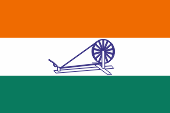 |
seit/since 1931, Flagge des Indischen National-Kongresses – flag of the Indian National Congress, Seitenverhältnis – ratio = 2:3, Quelle/Source: www.newworldencyclopedia.org |
 |
1943–1945, Azad Hind, Flagge der Provisorischen Regierung des Freien Indien – flag of the Provisional Government of the Free India, mehr Infos/more Info: Azad Hind ← hier klicken/click here |
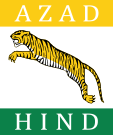 |
1943–1945, Azad Hind, Flagge Indische National-Armee – flag of the Indian National Army, mehr Infos/more Info: Azad Hind ← hier klicken/click here |
Jammu und Kaschmir – Jammu and Kashmir |
|
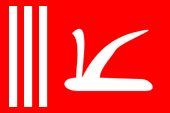 |
1957–2019, |
|
|
|
| Jammu und Kaschmir (genauer gesagt der indische Teil von Kaschmir) war der einzige indische Bundesstaat, der offiziell eine eigene Flagge führte. Am 05.08.2019 beschloss die Regierung Indiens die Aufhebung des Sonderstatus für den Bundesstaat aufzuheben und ihn in die zwei Unionsterritorien "Jammu und Kashmir" und "Ladakh" aufzuteilen. | Jammu and Kashmir (more precisely, the Indian part of Kashmir) was the one and only Indian federal state which officially used an own flag. On 5th of August in 2019, the Government of India decided to abolish the special status for the federal state and to divide it into the two Union Territories namend "Jammu and Kashmir" and "Ladakh". |
Sikkim |
|
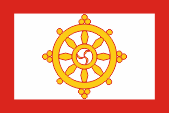 |
1967–1975, |
|
|
|
| Sikkim war einst britisches, nach 1947 indisches Protektorat, und wurde 1974 von Indien als Bundesstaat einverleibt. | Sikkim was once a British and after 1947 an Indian protectorate, and was in 1974 incorporated as a federal state by India. |
| Mehr Informationen? → Sikkim | more information → Sikkim |
Nagaland |
|
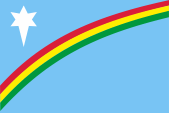 |
Flagge von Nagaland |
|
|
|
| Nagaland versuchte sich seit 1954 dem wachsenden indischen Einfluss zu entziehen, und wurde im Jahre 1962 Indien trotzdem als Bundesstaat angegliedert. Seither bewaffneter Widerstand unter dieser Flagge. | Nagaland tryed to deprive itself from the growing Indian influence since 1954 and was regardless incorporated to India as a federal state in the year 1962. Thereafter armed resistance under that flag. |
| Mehr Informationen? → Nagaland | more information → Nagaland |
Assam |
|
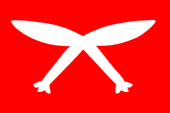 |
Flagge von Assam |
|
|
|
| Assam kam 1816 unter die Kontrolle des Königreichs Burma und wurde 1826 britisch. Von 1905 bis 1924 gehörte Assam zur Provinz Bengalen und wurde 1924 selbst zur Provinz erhoben. Im Jahre 1947 wurde Assam zwischen Indien und (Ost)Pakistan – dem heutigen Bangladesch – aufgeteilt. Den indischen Teil hat man zum indischen Bundesstaat erhoben. Wegen separatistischer Unruhen wurde im Jahre 1972 der Bezirk Mizo Hills von Assam abgetrennt und direkt von Neu Delhi aus verwaltet. Seit den 80-er Jahren des 20. Jahrhunderts gibt es auch in Assam separatistische Bestrebungen unter obiger Flagge. | Assam came in 1816 under the supervision of the
Kingdom of Burma and became British in 1826. From 1905 till 1924 Assam
belonged to the Bengalen Province and was levied to a province in 1924.
In the year 1947 Assam got shared between India and (East)Pakistan – the
today's Bangladesh. The Indian spare part was levied to an Indian federal state. Because of separatist agitations was the Mizo Hills District detached from Assam in the year 1972 and administered directly from New Delhi. Since the eighties of the 20th century there are separatist ambitions in Assam too, under the above flag. |
Khalistan (Sikhstaat – Sikh State) |
|
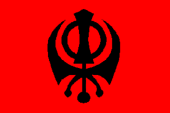 |
Flagge von Khalistan |
|
|
|
| Seit der Eroberung des Sikh-Staates durch die Briten im Jahre 1849 gab es immer wieder Bestrebungen der Sikhs sich der Zentralmacht zu widersetzen. 1947 wurde die Sikh-Provinz Pandschab sogar zwischen Indien und Pakistan aufgeteilt, was zur weiteren Destabilisierung der Region beitrug. Im Jahre 1984 kam es bereits zu offenen Kampfhandlungen zwischen den Sikhs und indischen Truppen, in deren Verlauf das Zentralheiligtum der Sikhs, der Goldene Tempel in Amritsar, von den indischen Truppen gestürmt wurde. Die Sikhs streben einen eigenen Staat unter obiger Flagge an, der Khalistan heißen soll. | Since the conquest of the Sikh State by the
British in the year 1849 there were ever again ambitions of the Sikhs to
resist the central control. In 1947 the Sikh Province Punjab was even
shared between India and Pakistan what some contributed to the further
destabilization in the region. In the year 1984 there were already outspoken fightings between the Sikhs and Indian troops, and in the course of them was raid the central sanctuary of the Sikhs, the Golden Temple in the town Amritsar by the Indian troops. The Sikhs aim for an own state under the above flag which should carry the name Khalistan. |
Mizoram (Tschinstaat – Chin State) |
|
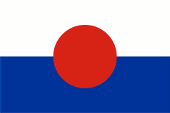 |
Flagge von Mizoram |
|
|
|
| Auf Grund separatistischer Unruhen des Volkes der Tschin wurde im Jahre 1972 der Bezirk Mizo Hills vom indischen Bundesstaat Assam abgetrennt und direkt von Neu Delhi aus verwaltet. Ende der 80-er Jahre des 20. Jahrhunderts wurde Mizoram zwar zu einem Bundesstaat erhoben, jedoch gelang es nicht die separatistischen Bestrebungen einzudämmen. Im Gegenteil, die aufständischen Tschin in Mizoram vereinigten sich mit den Tschin in Burma und streben einen gemeinsamen eigenen Staat unter obiger Flagge an. | Because of separatist agitation of the Chin people was separated the District of Mizo Hills from the Indian federal state Assam in the year 1972, and administered directly from New Delhi. At the end of the eighties of the 20th century Mizoram got levied to a federal state, however they failed to dam in the separatist ambitions. In opposite the insurgent Chin in Mizoram fused with the Chin in Burma and aim for a mutual own state under the above flag. |
| Mehr Informationen? → Mizoram | more information → Mizoram |